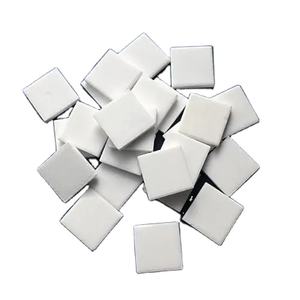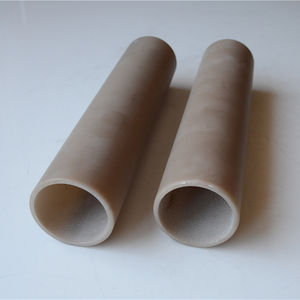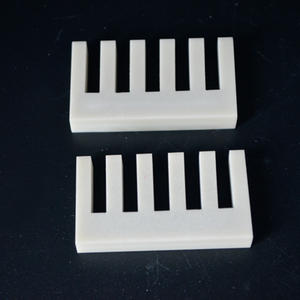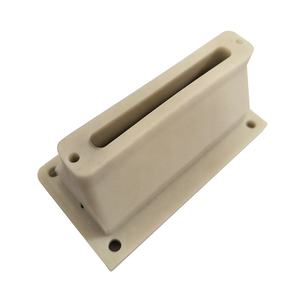Professional industry ceramic supplier, silicon nitride, silicon carbide, aluminum nitride and any other kinds of ceramics.
PRODUCT PARAMETERS
Description
Overview of High Purity Aluminum Nitride Aln for Ceramic Substrate
High Purity Aluminum Nitride Aln for Ceramic Substrate is an advanced technical ceramic renowned for its exceptional thermal conductivity and reliable electrical insulation. It is a key material in high-power electronics, LED lighting, and semiconductor processing, effectively managing heat in demanding applications where performance and reliability are critical.
Features of High Purity Aluminum Nitride Aln for Ceramic Substrate
- High Thermal Conductivity: Offers excellent heat dissipation, comparable to beryllia (BeO).
- Electrical Insulation: Maintains high electrical resistivity even at elevated temperatures.
- Low Thermal Expansion: Matches the coefficient of thermal expansion of silicon, ideal for semiconductor substrates.
- Excellent Mechanical Strength: Possesses good mechanical properties for structural integrity.
- High-Temperature Stability: Performs reliably in harsh environments and at high temperatures.
- Non-Toxic: A safe alternative to beryllium oxide (BeO) ceramics.
Specification of High Purity Aluminum Nitride Aln for Ceramic Substrate
This High Purity Aluminum Nitride (AlN) ceramic substrate material offers exceptional performance. It features very high purity, typically exceeding 99% AlN content. This purity is critical. Impurities negatively impact key properties. The material delivers outstanding thermal conductivity. Values range from 170 to 220 W/mK. This is much higher than alumina ceramics. Efficient heat dissipation is essential for demanding electronics.
AlN ceramic substrates provide excellent electrical insulation. They have high volume resistivity. This prevents current leakage. The material shows good dielectric strength. It withstands high voltages. The thermal expansion coefficient of AlN closely matches silicon. This is important. It minimizes thermal stress when bonded to silicon chips or devices. Reliability improves significantly.
The material possesses high mechanical strength. It is hard and rigid. This allows handling thinner substrates. Thinner substrates aid miniaturization. AlN resists chemical attack well. It performs reliably in harsh environments. This includes high temperatures and corrosive atmospheres. The material is non-toxic. It meets safety standards for electronic use.
Manufacturing processes ensure consistent quality. Tight control guarantees purity and properties. Applications include power modules, LED packages, and semiconductor equipment. AlN substrates handle high heat loads. They are ideal for high-power density circuits. Laser cutting and precision machining are possible. This achieves exact dimensions and tight tolerances. Surface finishes are available for metallization. This ensures strong bonds for circuit layers.
Applications of High Purity Aluminum Nitride Aln for Ceramic Substrate
High purity aluminum nitride ceramic substrates offer significant advantages in demanding electronics. This material handles heat extremely well. Electronic components generate heat during operation. This heat must go somewhere. Aluminum nitride moves heat away efficiently. It prevents dangerous temperature buildup. That protects sensitive parts. It also keeps performance stable. You see this in high-power LED lighting. Bright LEDs create intense heat. Aluminum nitride substrates manage that heat. They ensure long LED life and consistent light output. Power electronics use these substrates too. Think of electric vehicle systems or industrial motor drives. These applications push high currents. Aluminum nitride keeps power modules cool. That means better reliability and smaller designs.
RF and microwave devices benefit similarly. Signals travel fast. Heat is a problem again. Aluminum nitride provides a stable, low-loss platform. Signal integrity stays high. Another key point is thermal expansion matching. Materials expand when hot. Aluminum nitride expands at a rate close to silicon. Silicon is the base for most chips. This matching reduces stress. Connections between chip and substrate stay strong. It prevents cracking or failure. Electrical insulation is another vital feature. Aluminum nitride stops unwanted current flow. It isolates circuits safely even at high voltages. This combination is powerful: excellent heat spreading, good expansion match, and strong electrical isolation. Manufacturers choose aluminum nitride for critical thermal management tasks. It enables smaller, more powerful, and reliable electronic systems. Its performance is crucial where standard materials fall short.
Company Profile
Tanki New Materials Co.Ltd. focus on the research and development, production and sales of ceramic products, serving the electronics, ceramics, chemical and other industries. Since its establishment in 2015, the company has been committed to providing customers with the best products and services, and has become a leader in the industry through continuous technological innovation and strict quality management.
Our products includes but not limited to Aerogel, Aluminum Nitride, Aluminum Oxide, Boron Carbide, Boron Nitride, Ceramic Crucible, Ceramic Fiber, Quartz Product, Refractory Material, Silicon Carbide, Silicon Nitride, ect. please feel free to contact us.

Payment Methods
T/T, Western Union, Paypal, Credit Card etc.
Shipment Methods
By air, by sea, by express, as customers request.
5 FAQs of High Purity Aluminum Nitride Aln for Ceramic Substrate
What is High Purity Aluminum Nitride?
High Purity Aluminum Nitride is a ceramic material. It contains aluminum and nitrogen. It has very few impurities. This makes it ideal for demanding electronics.
Why use Aluminum Nitride for ceramic substrates?
Aluminum Nitride moves heat extremely well. It stops electricity from passing through. These traits are crucial for substrates. They keep electronic parts cool and safe.
What key properties does Aluminum Nitride have?
It moves heat 10 times better than alumina. It stays stable when temperatures change. It blocks electricity completely. It resists chemical damage. It stays strong under stress.
How is Aluminum Nitride made into substrates?
Pure AlN powder gets pressed into shapes. It bakes at very high heat. This makes it solid and dense. Then it gets cut and polished. The result is a smooth, flat substrate.
Where is Aluminum Nitride used?
It goes into LED lights and laser devices. It handles power electronics and radio circuits. It fits in electric cars and wind turbines. It works where heat must escape fast.
REQUEST A QUOTE
RELATED PRODUCTS

Aluminum Nitride Block Functional Ceramics for Aluminum Ceramics

High Insulation Resistance 200W/Mk Thermal Conductivity Aluminum Nitride Aln Ceramic Substrate for 5g RF & IGBT Power Modules

Customizable Aluminum Nitride Aln Ceramic Plate for Electronic Applications China Factory Low Whole

High Quality Aln Aluminum Nitride Small Ceramic Heat Sink

170 W/M. K Machinable Customized Aluminum Nitride Aln Wafer



